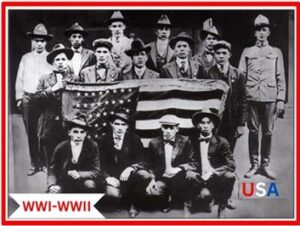The
Choctaw Code Talkers: Unsung Heroes of WWI and WWII
In
the annals of military history, code talkers hold a special place. They used
their native languages to transmit critical information, confounding the
enemy’s attempts to decipher vital communications. Among the most pioneering
were the Choctaw Code Talkers, deployed during the tumultuous years of World
War I and World War II. Their invaluable contributions remain an essential part
of American and Native American history.
A
Language as a Weapon
During
WWI, the U.S. Army faced a persistent problem: the Germans were adept at
intercepting and decoding American communications. In
an innovative move, officers in the 36th Infantry Division, which included
Choctaw soldiers from Oklahoma, realized the potential of the Choctaw language
– a complex and unwritten language unfamiliar to outsiders.
A
small group of Choctaw soldiers was recruited to develop a code. Leveraging
the intricacies of the Choctaw language, they used everyday words to represent
military terms (e.g., “big gun” for artillery), creating a nearly
impenetrable system for the Germans to crack.
Deployment
and Impact
The
Choctaw Code Talkers were strategically deployed in late October 1918 during
the Meuse-Argonne Offensive, a pivotal battle in the war’s final stages.
Their unique ability to relay troop movements, artillery coordinates, and other
sensitive information without the risk of interception proved to be a
game-changer. Their work is widely acknowledged for tipping the scales in favor
of the Allies in several crucial engagements.
While
the exact number of Choctaw Code Talkers is debated, their impact is
undeniable. Their unwavering bravery and ingenuity, demonstrated in the face of
a global conflict, helped turn the tide of the war and paved the way for using
Native American code talkers in future conflicts, most notably during World War
II.
Legacy: The
contributions of the Choctaw Code Talkers, which went largely unrecognized for
decades, have finally received the attention they deserve. It wasn’t until the
1980s that their story began to gain wider attention. Since then, their service
has been honored with memorials, documentaries, and the establishment of
Choctaw Code Talker Day.
Their
legacy is a testament to the resilience and ingenuity of the Choctaw people and
a reminder of the diverse contributions made by Native Americans to the United
States military. The Choctaw Code Talkers stand as a symbol of
how language can be a powerful weapon that, in this case, helped secure victory
and save countless lives.
While
the most well-known use of Choctaw Code Talkers was during WWI, their
contributions extended to WWII, although in a less documented capacity.
Limited
but Important Role
In
the early stages of WWII, the U.S. Army, remembering the success of the Choctaw
Code Talkers in WWI, once again turned to Native American languages for secure
communication. Several Choctaw soldiers were recruited and
trained in code talking. However, their deployment and specific actions in WWII
are not as widely documented as those of their WWI counterparts or the Navajo
Code Talkers, who played a prominent role in the Pacific Theater.
It’s
believed that Choctaw Code Talkers were deployed to various European theaters, including
North Africa and Italy, where they used their language skills to transmit
sensitive information. Though less publicized, their efforts
undoubtedly contributed to the Allied war effort.
A
Legacy of Service
The
exact number of Choctaw Code Talkers who served in WWII and the details of
their missions remain a subject of ongoing research. However, their
participation underscores the continued importance of Native American languages
in military communication and the willingness of Choctaw soldiers to serve
their country with unique skills and bravery.
The
legacy of the Choctaw Code Talkers in both WWI and WWII is a testament to the
vital role that Native Americans played in the U.S. military. Their story is of
ingenuity, courage, and language’s enduring power as a communication and
defense tool.
Interesting Note: In 1997, researchers at the OBI lab in Oklahoma City discovered a rare antibody, ENAV(MNS42), also known as “Avis,” in a Choctaw blood donation. The discovery was significant because it helped blood banks find blood for patients with the rare antibody, and only some members of the Choctaw tribe have compatible blood.
For
more information on Choctaw Code Talkers, you can refer to the following
resources:
The
Choctaw Nation Website: The Choctaw Nation’s official website
often features information about its history and culture, including the Code
Talkers.
The
National Museum of the American Indian has exhibits and resources on Native
American history and culture, including the Code Talkers.
The
Library of Congress: The Library of Congress collects primary and
secondary sources on the Code Talkers.
Sources
https://veterans.choctawnation.com/
https://en.wikipedia.org/wiki/Choctaw_code_talkers
Picture
Credit





